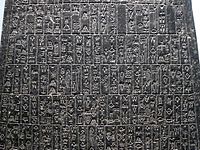Akkadian (llišānum akkadītum) or Assyro-Babylonian[7] was a Semitic language, part of the Afro-Asiatic language family, spoken in ancient Iraq.[8] The first-known Semitic language, it used the cuneiform writing system from ancient Sumer.[8][9]
| Akkadian | |
|---|---|
| Babylonian or Assyrian | |
| 𒀝𒅗𒁺𒌑(𒌝) Akkadû(m) | |
 Akkadian language inscription on the obelisk of Manishtushu | |
| Region | Mesopotamia |
| Era | c. 2600–500 BC; academic or liturgical use until AD 100[1] |
| Dialects | |
| Sumero-Akkadian cuneiform | |
| Official status | |
Official language in | Initially Akkad (central Mesopotamia); lingua franca of the Middle East and Egypt in the late Bronze and early Iron Ages. |
| Language codes | |
| ISO 639-2 | akk |
| ISO 639-3 | akk |
akk | |
| Glottolog | akka1240 |
History
changeThe earliest known Akkadian inscription was found on a bowl at Ur. It was addressed to a very early pre-Sargonic king of Ur by his queen Gan-saman, who is thought to have been from Akkad. The Akkadian Empire, established by Sargon of Akkad, introduced the Akkadian language, i.e. the "language of Akkad", as a written language. It used Sumerian cuneiform orthography (writing method) for the purpose.[8][9]
During the middle Bronze Age (Old Assyrian and Old Babylonian period), the language displaced Sumerian. Sumerian probably became extinct as a living language by the 18th century BC.[8][9]
Evolution
changeAkkadian is divided into several varieties based on geography and historical period:[8][9]
- Old Akkadian, 2500–1950 BC
- Old Babylonian/Old Assyrian, 1950–1530 BC
- Middle Babylonian/Middle Assyrian, 1530–1000 BC
- Neo-Babylonian/Neo-Assyrian, 1000–600 BC
- Late Babylonian, 600 BC–100 AD
References
change- ↑ "Neo-Assyrian". Archived from the original on 11 August 2011. Retrieved 2024-03-05.
- ↑ "Akkadian".
- ↑ I.J. Gelb. "Old Akkadian writing and grammar" (PDF). uchicago.edu. Retrieved 25 June 2023.
- ↑ "Babylonian dialect | Akkadian dialect | Britannica".
- ↑ Shlomo Izre'el (2007). "Canaano-Akkadian" (PDF). tau.ac.il. Retrieved 25 June 2023.
- ↑ von Dassow, Eva, "Canaanite in Cuneiform", Journal of the American Oriental Society, vol. 124, no. 4, pp. 641–74, 2004
- ↑ "Akkadian language". Britannica. November 5, 2024. Retrieved December 9, 2024.
- ↑ 8.0 8.1 8.2 8.3 8.4
- "The World's Oldest Writing - Recipes - Archaeology Magazine - May/June 2016". Archaeology Magazine. 2016. Retrieved December 9, 2024.
- Lidman, Melanie (June 17, 2023). "Groundbreaking AI project translates 5,000-year-old cuneiform at push of a button". The Times of Israel. Retrieved December 9, 2024.
- Anderson, Sonja (August 1, 2024). "Researchers Decipher Cuneiform Tablet—and Discover It's a Furniture Receipt". Smithsonian Magazine. Retrieved December 9, 2024.
- Levin, Claire (November 7, 2024). "Unraveling the ancient past, one tablet at a time". University of Chicago News. Retrieved December 9, 2024.
- Carvajal, Guillermo (December 5, 2024). "Analysis of Mesopotamian Texts in Akkadian Reveals How Emotions Were Experienced: Love Was Felt in the Knees". Magazine Cultural Independiente. Retrieved December 9, 2024.
- ↑ 9.0 9.1 9.2 9.3
- Reiner, Erica (April 1, 1966). A Linguistic Analysis of Akkadian. Vol. 21. De Gruyter Mouton. doi:10.1515/9783111356693. ISBN 9783111000282. Retrieved December 9, 2024.
- Cooper, Jerrold S. (1973). "Sumerian and Akkadian in Sumer and Akkad". Orientalia. 42. Peeters Publishers: 239–246. JSTOR 43079390. Retrieved December 9, 2024.
- George, Andrew (1997). "Languages of Iraq, Ancient and Modern". Babylonian and Assyrian: a history of Akkadian. London: British School of Archaeology in Iraq. pp. 31–71. ISBN 9780903472210. Retrieved December 9, 2024.
{{cite book}}: CS1 maint: location missing publisher (link) - Izre'el, Shlomo (1998). "Canaano-Akkadian: Some Methodological Requisites for the Study of the Amarna Letters from Canaan" (PDF). Lincom Europa. Retrieved December 9, 2024.
- Kouwenberg, N. J. C. (2010). The Akkadian Verb and Its Semitic Background. Penn State University Press. doi:10.5325/j.ctv1bxh2bd. JSTOR 10.5325/j.ctv1bxh2bd. Retrieved December 9, 2024.